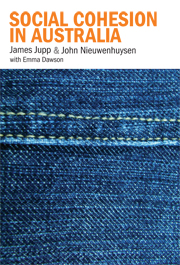Book contents
- Frontmatter
- Contents
- Foreword
- List of contributors
- List of tables
- Acknowledgments
- Introduction
- PART I DEFINING, MEASURING AND SEEKING SOCIAL COHESION
- PART II THE DYNAMICS OF SOCIAL COHESION
- 5 The landmark of Cronulla
- 6 Policing the other: Lebanese young people in a climate of conflict
- 7 Religious resurgence and diversity and social cohesion in Australia
- 8 Family and nation: the Indigenous/non-Indigenous relationship
- 9 Social cohesion and cultural fragility: a paradox of Indigenous rapports with Eurasian Australia
- 10 Educational attainments, inter-ethnic marriage and social cohesion
- PART III INFLUENCES AND RESPONSES IN SEARCHING FOR SOCIAL COHESION
- References
- Index
7 - Religious resurgence and diversity and social cohesion in Australia
Published online by Cambridge University Press: 22 September 2009
- Frontmatter
- Contents
- Foreword
- List of contributors
- List of tables
- Acknowledgments
- Introduction
- PART I DEFINING, MEASURING AND SEEKING SOCIAL COHESION
- PART II THE DYNAMICS OF SOCIAL COHESION
- 5 The landmark of Cronulla
- 6 Policing the other: Lebanese young people in a climate of conflict
- 7 Religious resurgence and diversity and social cohesion in Australia
- 8 Family and nation: the Indigenous/non-Indigenous relationship
- 9 Social cohesion and cultural fragility: a paradox of Indigenous rapports with Eurasian Australia
- 10 Educational attainments, inter-ethnic marriage and social cohesion
- PART III INFLUENCES AND RESPONSES IN SEARCHING FOR SOCIAL COHESION
- References
- Index
Summary
In the wake of terrorist attacks and increased social and cultural diversity, many societies, particularly post-industrial societies, are concerned about social cohesion. The rise of religious diversity, the resurgence of religious life and the return of religious issues to the political sphere are seen as part of the problem, but in so far as this is correct they must also be part of the solution. The call for ‘Australian values’ is both a response to the perceived challenges diversity poses to social cohesion and evidence of the difficulties in achieving any sense of unanimity on such issues in a religiously diverse society. While much of the current concern about social cohesion is code for Islamophobia, there is also a deeper issue at stake – the nature of social cohesion in post-industrial societies.
Many definitions of social cohesion conflate strategies to achieve cohesion, with cohesion itself (CDCS 2004). Some see social cohesion as the absence of conflict. For the purposes of this chapter, social cohesion refers to the ability of a society to so coordinate its resources as to produce what it needs to sustain and reproduce itself. Social theory argues that the basis of social cohesion in pre-industrial societies was cultural uniformity, while industrial societies were held together by the interdependence created by the differentiation of elements of production (Durkheim 1933).
- Type
- Chapter
- Information
- Social Cohesion in Australia , pp. 80 - 89Publisher: Cambridge University PressPrint publication year: 2007
- 6
- Cited by

